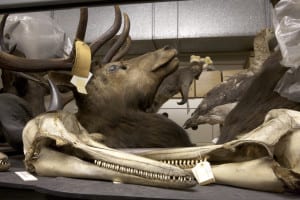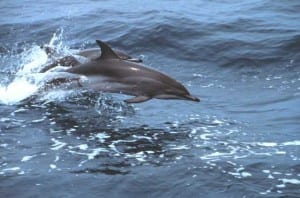Rediscovered: The Clymene Dolphin
Posted on by Fay Curtis.
by Bonnie Griffin, Natural History curator and Bill Brind, volunteer
 Recent rummaging in the natural history stores at Bristol Museum & Art Gallery has led to the uncovering of an interesting specimen; the skull of a Clymene dolphin (Stenella clymene), named after Clymene, daughter of mythical Greek divinity Oceanus.
Recent rummaging in the natural history stores at Bristol Museum & Art Gallery has led to the uncovering of an interesting specimen; the skull of a Clymene dolphin (Stenella clymene), named after Clymene, daughter of mythical Greek divinity Oceanus.
Clymene dolphins have unusual genetic history as the only known case of a marine mammal species created from the natural hybrid of two separate species, in this case, the spinner dolphin and the striped dolphin.
We were reviewing the cetacean material in store for an upcoming exhibition when dolphin skull Ag737 was found carefully packed in a box.
The skull was labelled as ‘(Clymenia) Prodelphinus Delphinus melis’, a Latin name that does not exist in the literature. It’s quite common for old specimens to have Latin names that are outmoded, misspelt or have changed in spelling when a species is reassigned.
After having no success finding a reference to melis in the literature, we investigated the specimen closely using a UV light and discovered the word metis was faintly written on the skull. From old books on cetaceans in the museums library collection, it was found that Delphinus metis is an old Latin name used to describe the Clymene dolphin and, confusingly, also the bottle-nosed dolphin!
Using comparative skulls in the collection, it was clear that the skull we uncovered was less robust, and had proportionally smaller teeth, than a bottle-nosed dolphin. Checking with the 1981 literature on Clymene dolphins, our skull matched the measurable proportions consistent with the diagrams in the paper.
The addition of the word Clymenia on the old label, stacked up the evidence that the skull did in fact belong to a Clymene dolphin, an exciting find, and the only skull of its kind in the collection.
 Clymene dolphins were first described by British zoologist John Edward Gray in 1846.
Clymene dolphins were first described by British zoologist John Edward Gray in 1846.
It was initially recognised as a sub-species of the spinner dolphin until a reassessment by a research team lead by W. F. Perrin in 1981 found enough distinctive physical features to have the Clymene dolphin reclassified as a separate species.
Further research by a Portuguese research team in 2004, this time looking at the DNA, also concluded that this dolphin is indeed a rare example of hybridisation resulting in a new species.
Our dolphin skull, now correctly identified and digitised by the natural history team is able to be viewed and researched by scientists all over the world, potentially helping with further discoveries on this unusual and special dolphin.
Find out more:
- Search our collections online
- Find out what our Natural History Team have been up to with the beautiful
Broughton Herbarium and our World Wildlife Gallery - Follow curator Bonnie Griffin on Twitter